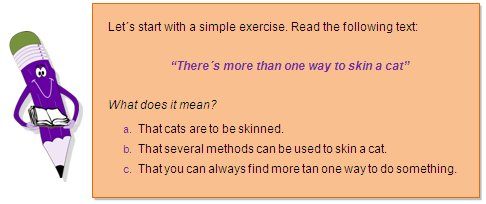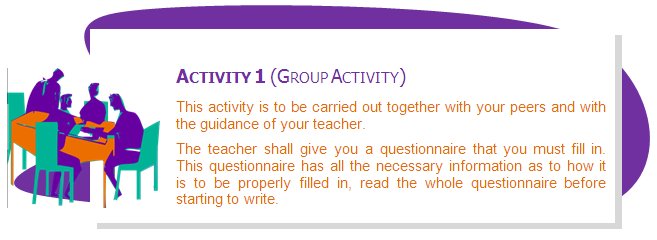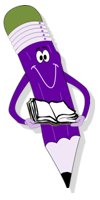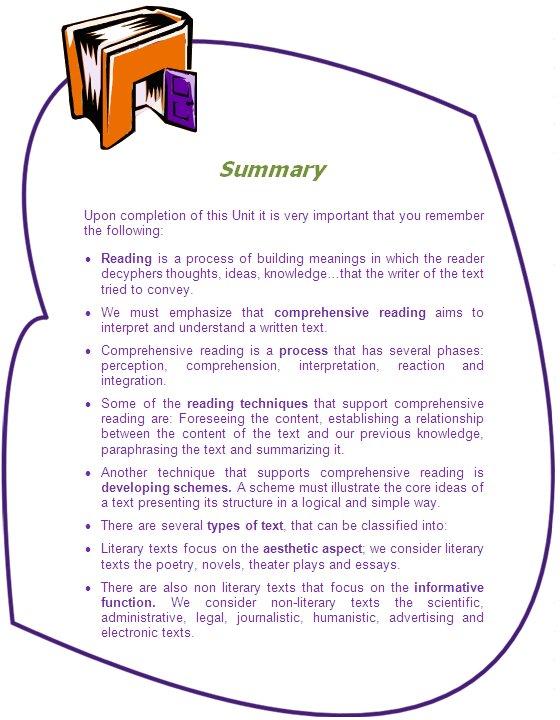Key Competencies Kit
for Facing Lifelong Learning


 |
This Project has been funded with support from the European Commission. This communication reflects the views only of the author, and the Commission can not be held responsible for any use which may be made of the information contained therein. |
 |
Upon completion of this Unit you shall be able to:
A great amount of the information that we usually receive reaches us by means of reading. Looking up a telephone number in the memory of our cell phone, looking up the schedule in a guide, checking the results of the lottery in the press…are examples of daily life situations where we use reading as the means to access interesting information.
However, limiting reading to an informative activity would be simplifying its value. Reading, in addition to providing information, allows us to communicate, as it is an excellent way to share among several people ideas and knowledge that would be very hard to share otherwise.
If we ask you if you can read, obviously you’ll say yes. In fact, most people can read. However, not everyone reads properly, meaning that we often misinterpret what we read, we confuse the main ideas of a text with the secondary ideas, we don’t process all the information conveyed in a written text…
In this Unit you shall realize that reading is a continuous process of communication between the person writing the text and the person reading it. In order for this communicative process to be properly developed we need to train our reading ability, and to learn how to use tools that facilitate an effective and comprehensive reading.
Let’s start by reflecting upon the following questions:
In Unit 1 we referred to how people distribute their time when communicating. Can you remember the percentage of time that was devoted to reading?
In fact, most people can read, in other words, we are able to interpret written signs, but, are we able to go beyond this?. Are we able to interpret the ideas, thoughts or concepts transmitted by these signs?. Meaning, Are we able to use reading as communicative tool, not only as an informative tool?.
Let’s start with a simple exercise. Read the following text:

If you have chosen answer a or b, you were wrong. You have just interpreted the graphic signs (i.e. the letters), but you have not gone beyond that.
If you have chosen answer c, we must congratulate you and tell you that, in addition to interpreting the graphic signs (letters and words), you have been able to interpret the idea underlying this text.
This is exactly what we do when reading. From now on, we shall use this reading concept.
Reading is a process in which meanings are built, where the reader decyphers the thoughts, ideas, knowledge, etc. that the person that wrote the text was trying to convey. |
If we go back to the knowledge acquired in Unit 1, we can state that reading is a communicative process in which a sender (writer) conveys a message (ideas, thoughts, knowledge…) to a receiver (reader), being written words the code used.
Based on this definition, you shall realize that oftentimes what we do is interpreting the graphical signs. The difference between interpreting graphical signs and reading is similar to the difference we have established in Unit 3 between hearing and listening. In other words, reading means moving a step forward in the interpretation of written words.
Below we suggest different situations. You must briefly describe how you use reading in each of them:
You are in a supermarket and, in order to get out of the place you follow the signs indicating “EXIT”:
You need to read the instructions to learn how to use your DVD player:
You are driving and you see a STOP sign:
You are on vacation and decide to read the last novel of your favorite writer.
You are having breakfast in a coffee-shop and you read a newspaper:
You receive an SMS from a friend congratulating you on your birthday:
You receive a telephone bill indicating the amount to be paid:
You receive an invitation to a carnival party:
You are about to sign a job contract for a company:
As you have seen, depending on the type of written text and on our needs, we are going to use different ways of reading. However, in all situations we need to move one step forward as we have mentioned before in order to understand the message being conveyed. If we would only interpret the graphical signs, we would not stop our car before the stop sign, we would not be able to view a dvd, we would not know when and where is the carnival party, etc.
As you have infered, not all texts require the same effort or level of comprehension, however, this effort is necessary for the communicative process between writer and reader to be effective.
Comprehensive reading is a way of reading that aims to interpret and understand a written text. |
In comprehensive reading the reader plays an active role, in other words, decodes the message, analyzes it, thinks of questions, builds personal opinions, etc.

INSTRUCTIONS OF THE QUESTIONNAIRE |
First Name: |
|
 |
What is the reason that explains the mistakes made by some of your peers when interpreting the instructions of the questionnaire?
What happens when we don´t read?
What do we need in order to know what we have to do?
|
In the previous section, we asked you to describe briefly how you would use reading in each of the situations suggested. Now we ask you to reflect upon the following questions:
In which of the suggested situations do you think it would be harder for you to understand the written text?. Why?
When you read, do you usually follow an established process?
Eventhough we often use reading in an automated way, meaning, we don’t reflect upon how we are reading, the fact is that if we want to understand the entire meaning of a text we should follow a process that ensures an effective reading.
In order to learn such a process, you should follow the following instructions:
 |
Read the following text just once: Have you understood the meaning of this poem?..................................... Probably not. So far, what you have done is recognizing the graphical signs, in other words, you have brought together letters and words, therefore we cannot call this comprehensive reading. |
Read the text again.
This time you can do it slowly and taking your time to analyze the meaning of the words.
You probably do, if not you should use a dictionary. So far, we can say that we have gone a step forward, we partially understand the meaning of the text (word by word).
Read the text again.
but this time you must put yourself in the place of the person who wrote it and try to understand what he wanted to communicate.
If you need, read the text again.
If you are able to remember the general meaning of the text, answer the following questions regarding your opinion on the text:
Last, you are going to assess the text according to what it brings to you:
By means of the instructions and questions that we have suggested, you have followed the phases that make up the comprehensive reading process .
Comprehensive reading is a process that includes several phases:
|
You are probably thinking that this reading process might not be very useful, and even rather complicated. Bear in mind, that most times this process is automated and unconscious, especially if you get used to using comprehensive reading regularly.
|
Imagine that a written text is n onion and we have to remove one layer after another to reach its core. Through comprehensive reading we shall discover hidden meanings and eventually we shall reach the meaning that the writer wanted to convey, and this is, at the end of the day, the aim of reading. |

Your teacher shall tell you which is the most important news of the day and everyone must gather interesting information related with it.
You must form 4 groups. Each group must look up a different newspaper (the teacher shall hand out the newspapers), and then must briefly (1 line) answer the following questions:
What has happenned?
When and where has it taken place?
Who is involved?
 |
Have all groups answered the same?. Why?
Has any of the groups made a reading mistake?, If so, what is it?
What can a Reading mistake mean?
|
In the previous sections you have seen the importance of learning how to read in a comprehensive way. If we don’t use this type of reading, we won’t interpret the meaning of the written text completely and, therefore, we shall be dismissing information that can be very useful or interesting. But, comprehensive reading is no always easy. Which tools do you think could be very useful?
In the following activities you shall discover some tools that can be very useful in order to understand a written text.
Let´s start.... Please, read the following text:

Note that we have started by foreseeing the meaning of the text based on the title, in other words, we start to figure out what could be the meaning of the text.
Let´s continue… Read the beginning of the text: |
-I’m frightened-. He whispered to his friend, he arranged his raincoat and dashed down the street. -Don’t worry, it won’t happen while you are with me, I can protect you and look after you better than anyone. Tried to tell him Jaime, while he ran beside him and watched if anyone was following them. The situation was getting tough, the flee wouldn’t be easy and only if they stayed together would they have a chance to get away from that place that have brought them so much pain and harm. The warehouse of the harbor where these two children have worked for so many years have turned into a prison where the might of the employer was all over bringing terror and wrath to everyone around. |
In order to decypher the meaning of this text, you should try to relate the title with the situation narrated by the writer.
Now, see that what we are doing is activating our previous systems or knowledge and linking them with the words of the text, in order to be able to decypher its content and understand it.
Let’s see this text more into detail.
Now, you must paraphrase what you have read, i.e., you must tell us the content of the text in your own words.
.....................................................................................................................................
In order to paraphrase the text you should read it again, focusing on the underlined words, and try to remember what is being said, not learning it by heart, but rather using your own words.
Now you summarize the main idea of the text.
In order to do so you must try to answer the following questions (remember that you must provide brief answers, i.e., in order to summarize you need to paraphrase):
What is the main (most important and unavoidable) idea of the text?
Which are the secondary ideas (support information, that is necessary to understand the text as a whole?
What is this text about? (Start indicating the main idea and then, step by step, add the secondary ideas).

A book is a set or collection of written, printed, illustrated, or blank sheets, made of paper, parchment, or other various material, usually fastened together to hinge at one side. A single sheet within a book is called a leaf, and each side of a leaf is called a page. A book produced in electronic format is known as an electronic book (e-book).
 |
Books may also refer to a literature work, or a main division of such a work. In library and information science, a book is called a monograph, to distinguish it from serial periodicals such as magazines, journals or newspapers. The body of all written works including books is literature. |
Do you know the meaning of all words?. Use a dictionary to look up the meaning of those words that you don´t know.
What is a leaf?
What is a bookworm?
What is an e-book?
What is the main idea of the text?
Which are the secondary ideas?
What is a book?. Summarize the definition above.
Some of the reading techniques that support comprehensive reading are:
|
As you have seen, summarizing is one of the most useful tools in order to understand the meaning of the text. However, summarizing is not always easy.
Another technique that supports comprehensive reading and can be an option or a complement to summarizing is developing schemes. |

United Nations is an International organization founded in 1945 after World War II by 51 nations that committed themselves to maintain International peace and security, develop friendly relationships among nations and foster social advances, better living standards and human rights. Due to its International nature and to the competences established in its founding Charter, the Organization can make decisions on a wide range of issues, and provides a forum to its 192 Member States to voice their opinions, through the General Assembly, the Security Council and the Economic and Social Council.
The work of the United Nations reaches all over the World. In spite of being mostly known for maintaining peace, consolidating peace, preventing conflicts and delivering humanitarian aid, there are many other ways in which the United Nations and its system (special bodies, funds and programs) affect our lives and make the world a better place. The Organization works on a wide range of issues, from sustainable development, environment and protection of refugees, disaster relief, fight against terrorism, disarmament and non-proliferation, fostering democracy, human rights, governance, economic and social development, international health, clearing of landmines, increasing the production of food, among others, in order to achieve its goals and coordinate the effort to build a safer world for future generations.

Other recommendations that support comprehensive listening:
|
We already know the meaning of the action of reading, we also know the importance of using comprehensive reading, we have even practiced with some techniques that support comprehensive reading.
Now, it’s time to reflect upon your own reading habits.
In order to do so, you must briefly answer the following questions:
Do you like reading?. Why?
What type of texts do you usually read?. Provide and example.
Have you wondered how many types of text there are?

| a./ A literary text uses words in a poetic manner, looking after the aesthetical aspects. |
1./ The Council of the European Communities adopts the following resolution.
The Council takes notes of the communication of the Commission on the guidelines for a EU policy on migration. |
| b./ A scientific text aims to present or prove development based on scientific research. |
2./ Mr/Mss..
CERTIFIES THAT: In relation with the application for a unemployment benefit, the data of the firm are true and accurate, as well as the personal, professional and tax data of the worker, which are included below (…) |
| c./ Administrative texts aim to be a means of communication between people and institutions (firms, entities, organizations, administration, etc.) |
3./ “We’ve done a greate effort to creat a unique car, just like you”.
(Car advertisement) |
| d./ Legal texts are developed in the process of administering justice. |
4./ “But I can give more than that: I shall make a golden statue of Juliet and, as long as Verona keeps its name, there won’t be an statue so much appreciated as that of the constant and loyal Juliet (…)”.
(Extract of Romeo and Juliet, William Shakespeare) |
| e./ Journalistic texts are all texts related with journalistic communication (newspapers, magazines, etc.) |
5./ “The Lorentz contraction and the scalar mass, can be applied to study a flat space-time in inmaterial reference systems that are exclusively inertial but, in order to study the curved space-time and in general reference systems of the General Relativity they are not appropriate (...)”.
(The general relativity formulated without the traditional tensors of Einstein by Heber Gabriel Pico Jiménez) |
| f./ Humanistic texts develop any aspect of human sciences such as psichology, sociology, anthropology, etc. |
6./ Closing of the Barcelona summit
“The UN assumes that no binding treaty shall be agreed upon in Copenhaguen” |
| g./ Advertisign texts aim to convince the reader about the qualities of a commodity, in order to sell it. |
7./ Sexuality in the third age
The population aging phenomenon takes places gradually and it involves fertility, mortality and migrations. This variables combined in time determine the growth and the age structure of the population; highly important for the economic and social planning of any country (…). |
| h./ Electronic texts are based on the use of ICT’s (e-mail, cell phone, etc.) |
8./ Today we’ll meet at 5 o’clock in the coffee-shop of the shopping center, we’ll see you there ;-)
(SMS) |
As you have seen there are several types of texts. In general, we can refer to literary texts, which focus on the aesthetical aspect; we consider literary texts the poetry, novels, theater plays and essays. |
 |
Remember!There are many types of texts, therefore, with such a wide range it’s easy for you to choose one type as your favorite. You should put into practice the comprehensive reading techniques that you know with the type of texts that you most like. |

 |
Response to issues and activities outlined in the Didactic Unit 4 |
We provide you with the following information in relation with the text suggested:
Do you know the meaning of all the words? Look up the meaning of those words that you don’t know in a dictionary.
You should have always a dictionary with you. This resource shall help you to understand the meaning of texts, and also to prevent spelling mistakes. In addition, in Internet there are many online dictionaries and encyclopedias available that support comprehension.
What is a leaf?
A leaf is a single sheet within a book.
What is a bookworm?
A lover of books.
What is an e-book?
A book produced in electronic format.
What is the main idea of the text?
A book is a piece of work, that can be produced in several formats (physical or electronic), and aims to develop a certain subject.
Which are the secondary ideas?
Books can have a literary content or an informative content. The body of all written works, including books is called literature.
In novels, a book may be divided into several large sections, also called books.
A lover of books is usually referred to as a bibliophile or, more informally, a bookworm.
A store where books are bought and sold is a bookstore or bookshop. Books can also be borrowed from libraries.
What is a book? Summarize the definition above.
A book is a set or collection of written, printed, illustrated, or blank sheets, made of paper, parchment, or other various material, usually fastened together to hinge at one side. A book produced in electronic format is known as an electronic book (e-book).
The scheme that you have developed, depending on the structure that you have chosen, must be similar to the following proposal:

The correct relationship between the suggested texts and types of texts is the following:
a-4; b-5; c-2; d-1; e-6; f-7; g-3 and h-8.